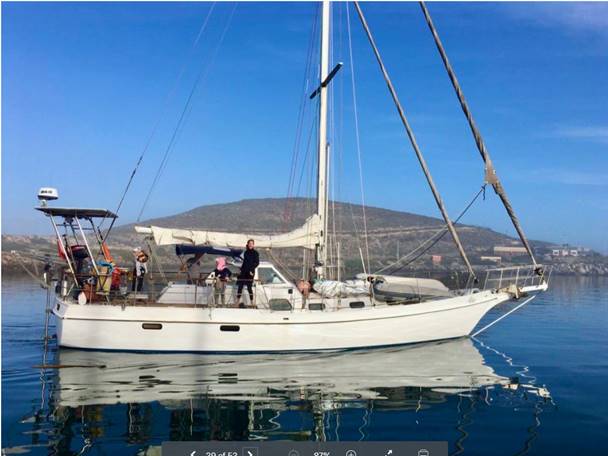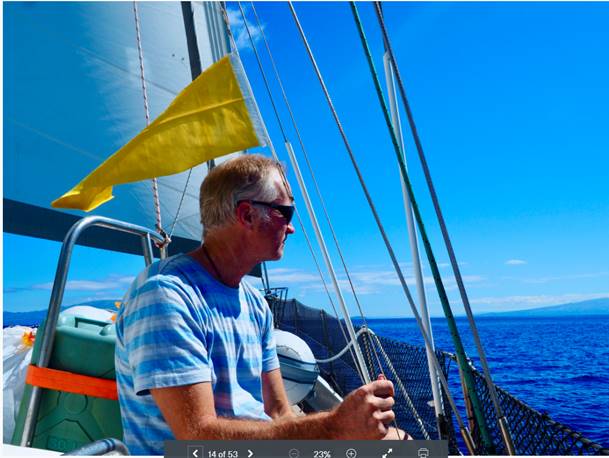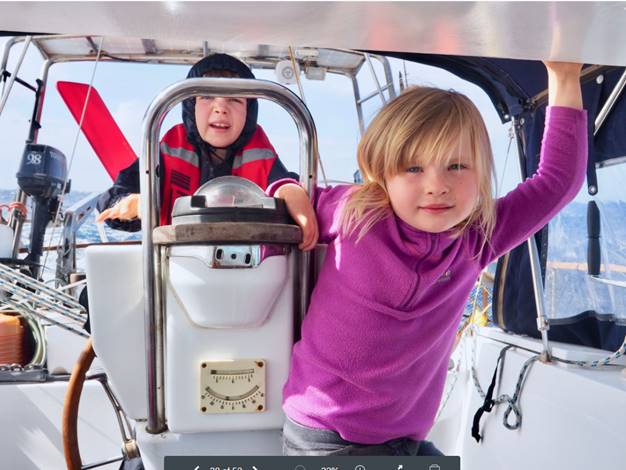John and I did a fair amount of running around the globe in 2020 despite the world’s best efforts to thwart us. At the start of the year we wrapped up our jobs in New Zealand and packed our bags for South Africa where we had left our boat. We visited lion facilities and giraffe parks, butterfly farms and monkey centres and explored the vast network of regional parks. We spent a week on safari in the Kgalagadi Trans Frontier Park where we watched a cheetah kill, lion cubs frolic, giraffes spar and wildebeest fight.
At the beginning of March we turned our focus from tourism to seafaring. The boat had been sitting on the hard in a boatyard two hours north of Cape Town and we moved onboard to begin an intense two week smash-out of boat jobs before shooting off into the Atlantic by mid-March. As we powered through our job list we were receiving news that countries across the globe were starting to close their borders and our options were disappearing the closer we got to casting off our lines. England and Europe had closed their borders. The Caribbean had closed its borders. Namibia was expected to close its borders. St. Helena would follow suit. By the day, all of our intended destinations were denying entrance. The global lockdown had become a severe impediment to our plans. While most of our friends thought we were in an ideal situation and told us that heading off to sea was the best option for safety from Covid-19, few realised that we were a ship without options. We could leave, but we could never arrive. As the risk of being “stuck at sea” was too great, we decided our best option was to stay put and prepare.
As public announcements were being made across the country that Covid-19 was not going to impede life in South Africa and for the public to remain calm, we were piling food in our four-trolley train while onlookers shook their heads, tutted and glared at our stock-pile of goods. While we may have offended the general public, we were met with much laughter by the marina staff as they watched our liquor stocks being unloaded onto the dock. I’d been out exploring a local wine region the day before President Ramaphosa was due to make a public announcement; fortunately the cellar owner had caught wind of a possible change in the lockdown level in advance and warned me it may be the last hour before sales would be capped. We negotiated a deal on 150 bottles of wine. She had been correct; the following day Ramaphosa announced a ban on all liquor sales. We had the last laugh after all.

We were closing in on our long list of essential repairs before the inevitable happened: South Africa went into national lockdown. On 17th of March Ramaphosa implemented one of the strictest lockdown measures adopted by any nation: The borders were closed, international flights were cancelled and the ports were shut down. All non-essential services were closed, social gatherings were banned, domestic travel was banned, the consumption and sale of alcohol and cigarettes was banned, public exercise was banned, a curfew was rolled out, restaurants and shops shut down, schools shut down and everyone was required to remain in their homes. Covid-19 descended upon South Africa and overnight the country shut down.
Our basecamp was in a small marina that was situated on port property just outside the sleepy town centre of Saldahna Bay, 50 miles north of Cape Town. This lacklustre town became an unexpected oasis when the lockdown hit. While other cruisers in more idyllic settings were confined to their cabins onboard their boats, we had a unique freedom afforded us by our location. Our marina was built on a peninsula owned by the Port that oversaw all the boat traffic this side of the bay. We had guards protecting the entrance and an observation tower ensuring our safety from the sea. While the national guards and the local police were dispatched to make sure everyone was staying home and obeying the lockdown rules, we were free to roam our secluded reserve unhindered. For a family living in tight confines, this was significant to our overall mental health.
Life on lockdown immediately went from frenetic to relaxed. The flurry of sight-seeing activities and myriad of extensive boat jobs slowed down to a quiet daily routine which included a walk around the peninsula before schoolwork onboard followed by an afternoon of beach games which often lead to sunset cocktails with the seven other cruisers stuck in lockdown with us. After two months of lockdown, rather than sit and wait for the borders to reopen, we decided to cut our losses and move on. What this meant to us is that by leaving we would forfeit our stops in Namibia, St. Helena and Ascension. Not only would we lose out on seeing those notable destinations, it also meant a long-haul from South Africa to the Azores.
Rather than a soft launch to a bigger journey via these neighbouring countries, we would have to depart South Africa for the 6,000-mile direct transit to Europe. We would travel from 33 degrees south of the Equator to 38 degrees north and cross five distinct weather patterns, each approximately 1000 miles in distance. Not only is this significant in mileage, it meant we would tackle our longest passage after the boat had been ashore and our repairs untested for the previous two years. To be mentally prepared for this length of time at sea, we would measure our trip in 1000 mile chunks and celebrate each section as a milestone along the way.
We would need to leave under the cloak of darkness without gaining proper clearance documentation or getting permission from the South African government. On a foggy early morning in early June we cast off our lines and sailed out of the bay under the nose of Port Authority. Tensions were high as we made for sea and we all kept a watch out for any fast moving vessel heading in our direction. Fortunately, there was nothing chasing us other than a pod of fifty dolphin that we nostalgically took as a warm welcome to our return to the ocean. The only other contact we had for the next fifty-two days came that afternoon when a boat raised us on the VHF. My heart pounded as we returned the call… was it maritime police calling us back? We tentatively returned the call and received an enthusiastic greeting from a fellow New Zealander who had seen the registration of our vessel on AIS. We were both 100 miles off the coast of South Africa having a friendly chat about local weather and home. The odds were beyond belief.

That was day one of a fifty-two day sail from the South Atlantic to the North Atlantic. Over the following week we maintained a 100 mile distance from the coastline, trying to keep a comfortable distance between us and the authorities. We settled into watch-keeping and schoolwork routines and reacquainted ourselves with cooking on unstable surfaces as the coastlines of South Africa, Namibia and Angola passed down our starboard side.
The strong winds gradually moderated and the temperatures increased to a pleasant mid-20 degree heat, the conditions onboard settled as we rolled into the southeast trades. With perfect sailing conditions, our days slipped into a comfortable routine of morning schoolwork, afternoon siestas and games in the early evening. Life rolled at a blissful pace as our memory of lockdown and the global crisis slipped away.
As we sailed past the equator and into the doldrums, we needed to look towards the second half of our journey and the challenge of finding a route into the northern hemisphere weather patterns. With a reliable diesel engine and large-capacity fuel tanks we didn’t have to worry about being becalmed for weeks but we did need to retain enough fuel for the approach to the Azores. We considered two routes: A westerly path means a better likelihood of wind and less motoring, but a longer distance to travel and a worse sailing angle on the approach to our destination. An easterly path offers a shorter distance and better sailing angle but we may burn up our diesel reserves in light weather so that we risk being becalmed within sight of the finish line. As a further complication to planning, a lack of remaining satellite minutes meant that our weather map was out of date – our final path was based on outdated science and a prudent amount of silent prayer.

The toughest stretch of the voyage came as we departed the doldrums and entered the northeast trades – named “trades” for the reliable winds that come from the northeast. For centuries these winds have been the sailor’s friend; however, these winds are only friendly if you are going downwind. Taking them on the nose, as we were, is a very different situation. We battled these winds for four long days, taking wave after wave over the bows and stripping life on board down to the basics – eat, try to rest, give up on restless rest, go on watch. The kids were unaffected by the weather but keeping it all together as sailor, parent and partner was emotionally demanding as John and I maintained watch-keeping schedules, fed the family, entertained and schooled the kids while being tossed inside a lurching boat that was being battered by an onslaught of rough seas.
As we entered the semi-stationary sub-tropical area of high pressure and low winds in the mid-Atlantic known as “The Azores High”, the excitement that our two month ocean odyssey was near its conclusion was equally high. While conditions had eased, so had the wind. We were running our engine on empty given the motoring we had to do in the doldrums. We had a jerry can of fuel on deck as our “last resort,” and we poured our last remaining thimble-full of fuel with landfall just out of sight. We held our breath as we puttered into the anchorage, knowing we had no wind and almost no fuel to see us through to our destination. Dropping the anchor has never felt so sweet: We had successfully completed a 5,888 mile passage from Saldahna Bay in South Africa to Horta in the Azores.
As we rolled into the Azores it was clear they had an efficient process in place. We were greeted by two men in PPE suits an hour after arrival with a bag of hamburgers in one hand to complement the champagne we were drinking and a bag of fresh vegetables in the other. We were told to stay onboard for the night but invited ashore in the morning for a free Covid test with a 24-hour turn around on the result. By the morning of our second day we were officially welcomed into the country and given permission to travel freely throughout the islands. While our friends remained locked down in the marina for the past several months, shivering through the winter weather and revising potential plan after potential revised plan, we were sailing around the archipelago, sightseeing our way through the rich, volcanic islands and socialising with the warm, hospitable locals we met along the way. In the high-stakes game of “to go or not to go,” the Azores was our sweet reward.



